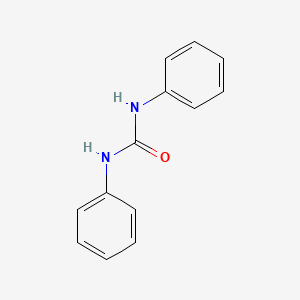D0895 | diphenylurea
| Toxicity | Dose | Time | Species | Model | Method | Action | Positive criterion | Reference |
|---|---|---|---|---|---|---|---|---|
| MEMBRANE POTENTIAL | 1.60±0.74 | human | qHTS-HepG2 | MMP assay | decrease | IC50 | 163 | |
| MEMBRANE POTENTIAL | 2.51 | human | HepG2 | MMP assay | decrease | IC50 | 163 | |
| MEMBRANE POTENTIAL | 8.46±2.39 | rat | hepatocytes | MMP assay | decrease | IC50 | 163 | |
| Pictogram | Signal | Statements | Precautionary Statement Codes |
|---|---|---|---|
 |
Warning |
Aggregated GHS information provided by 4 companies from 3 notifications to the ECHA C&L Inventory. Each notification may be associated with multiple companies. Reported as not meeting GHS hazard criteria by 1 of 4 companies. For more detailed information, please visit ECHA C&L website Of the 2 notification(s) provided by 3 of 4 companies with hazard statement code(s): H302 (100%): Harmful if swallowed [Warning Acute toxicity, oral] H312 (33.33%): Harmful in contact with skin [Warning Acute toxicity, dermal] H332 (33.33%): Harmful if inhaled [Warning Acute toxicity, inhalation] Information may vary between notifications depending on impurities, additives, and other factors. The percentage value in parenthesis indicates the notified classification ratio from companies that provide hazard codes. Only hazard codes with percentage values above 10% are shown. |
P261, P264, P270, P271, P280, P301+P312, P302+P352, P304+P312, P304+P340, P312, P322, P330, P363, and P501; (The corresponding statement to each P-code can be found at the GHS Classification page.) |
| 1 pound not3-diphynylurea | 1, 3-Diphenylurea | 1,3-Diphenylcarbamide |
| 1,3-Diphenylurea | 1,3-Diphenylurea, 98% | 1,3-Diphenylurea, Vetec(TM) reagent grade, 98% |
| 1,3-diphenyl-urea | 102-07-8 | 2zjf |
| 3e85 | 4-12-00-00741 (Beilstein Handbook Reference) | 94YD8RMX5B |
| AB1002487 | AC-12855 | ACMC-209800 |
| AD 30 | AI3-52320 | AK106179 |
| AKOS000312994 | ANW-14638 | AQ-917/40171059 |
| Acardite | Acardite I | BDBM25725 |
| BRD-K13027645-001-02-0 | BRN 0782650 | BSPBio_003055 |
| CARBANILIDE | CAS-102-07-8 | CBDivE_002165 |
| CCG-38465 | CCRIS 4634 | CHEBI:41320 |
| CHEMBL354676 | CTK0H5222 | Carbanalide 100 microg/mL in Acetonitrile |
| Carbanilide | DB07496 | DSSTox_CID_5183 |
| DSSTox_GSID_25183 | DSSTox_RID_77698 | DTXSID2025183 |
| Diphenylcarbamide | Diphenylurea | DivK1c_006502 |
| EINECS 203-003-7 | EU-0067898 | F0316-0002 |
| FS-4202 | FT-0606720 | GEO-04213 |
| GWEHVDNNLFDJLR-UHFFFAOYSA-N | HSDB 2757 | ICCB1_000093 |
| InChI=1/C13H12N2O/c16-13(14-11-7-3-1-4-8-11)15-12-9-5-2-6-10-12/h1-10H,(H2,14,15,16; | KBio1_001446 | KBio2_000902 |
| KBio2_003470 | KBio2_006038 | KBio3_002275 |
| KBioGR_002082 | KBioSS_000902 | KS-00000WTV |
| KSC175E2F | Karbanilid | Karbanilid [Czech] |
| Kinome_598 | Kinome_627 | L-5305 |
| LS-354 | MCULE-4684667909 | MFCD00003017 |
| MLS002207104 | N'N'-Diphenyl urea | N, N'-diphenylurea |
| N,N inverted exclamation marka-Diphenylurea | N,N'-Difenylmocovina | N,N'-Difenylmocovina [Czech] |
| N,N'-Diphenylurea | N,N'-Diphenylurea, 97% | N,N'-bis-Phenylurea |
| N,N'-diphenyl urea | N-Phenyl-N'-phenylurea | N-phenyl(phenylamino)carboxamide |
| NCGC00091344-01 | NCGC00091344-02 | NCGC00091344-03 |
| NCGC00091344-04 | NCGC00091344-05 | NCGC00257622-01 |
| NSC 227401 | NSC-227401 | NSC-8485 |
| NSC227401 | NSC8485 | Oprea1_527136 |
| Q27096716 | RKL10128 | RTR-000546 |
| SBB058217 | SCHEMBL133103 | SCHEMBL21313806 |
| SDCCGMLS-0066513.P001 | SMR000112141 | SPBio_001915 |
| SPECTRUM211126 | SR-01000398115 | SR-01000398115-1 |
| SR-01000398115-2 | ST45141119 | STK328350 |
| SpecPlus_000406 | Spectrum2_001838 | Spectrum3_001328 |
| Spectrum4_001561 | Spectrum5_000182 | Spectrum_000422 |
| TR-000546 | TRA0086633 | Tox21_200068 |
| UNII-94YD8RMX5B | USAF EK-534 | Urea, 1,3-diphenyl- |
| Urea, N,N'-diphenyl- | Urea,3-diphenyl- | Urea,N'-diphenyl- |
| Urea-based compound, 7 | VZ36373 | W-108886 |
| WLN: RMVMR | ZINC12416741 | Zeonet U |
| bis-phenyl-urea | n,n'-diphenyl-urea | s-Diphenylurea |
| sym-Diphenylurea |

